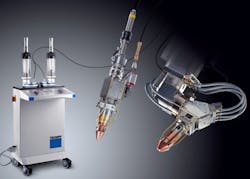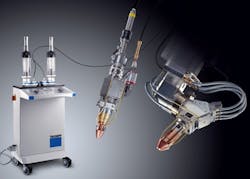Savings made possible with laser metal deposition
Farmington, Conn. – The potential to save resources with laser deposition welding is huge, according to TRUMPF. The company suggests this method can lead to 90% savings in materials and material costs.
Laser metal deposition (LMD) can be used to repair and optimize parts by enhancing their durability. It is a technology that can benefit all industries from petrochemical and automotive to medical engineering. Its economic potential involves improving the life of components by introducing a resistant layer that increases their temperature, corrosion, and wear resistance. A good example would be LMD-reinforced oil drill components.
The second important application field for LMD is the repair of expensive components that have some localized damage but remain functional, for example, turbine blades.
In laser deposition welding, the laser beam produces a molten bath on the surface of the component into which metallic powder is sprayed into the beam. The direction of the sprayed powder can be co-axial to the laser beam or via multijet or sidejet techniques. Depending on the application, different materials and powder mixes are used so that the properties of the layer can be precisely determined. Iron, cobalt, titanium, and nickel alloys as well as material containing carbides are good candidates.
In most cases, the welding seams have a height of 0.3 to 1.2 mm and a width between 0.3 and 3 mm. To increase layer strength, multiple seams can be deposited on top of the eachother. An important advantage of this technology is that it applies minimal heat to the work piece so the component is in no danger of warping.
With each pass, successive layers are applied to enhance the work piece surface or repair wear damage and restore the component’s original geometry. By so doing, the procedure can also form three-dimensional structures such as the tip of a turbine blade.
To achieve the optimum system for the LMD task, TRUMPF provides complete technology packages that include all the hardware, software and consumables for the application. For smaller components, TRUMPF recommends its TruLaser Cell 3008 as the basis of the system and for larger parts, the TruLaser Cell Series 7000 or TruLaser Robot 5020.

